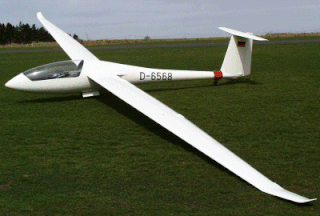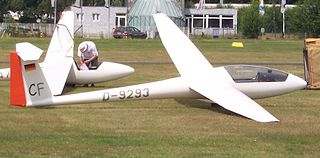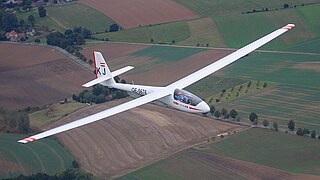
The Schempp-Hirth Discus is a Standard Class glider designed by Schempp-Hirth. It was produced in Germany between 1984 and 1995 but has continued in production in the Czech Republic. It replaced the Standard Cirrus. It was designed by Klaus Holighaus.

The Schempp-Hirth Ventus is a sailplane produced during 1980–1994 by Schempp-Hirth, a German sailplane manufacturer. It was designed by Klaus Holighaus and replaced the Schempp-Hirth Mini-Nimbus. Schempp-Hirth manufactured 613 Ventus sailplanes.

The Rolladen-Schneider LS4 is a Standard Class single seat glider manufactured by Rolladen-Schneider Flugzeugbau GmbH between 1980 and 2003.

The Schempp-Hirth Mini Nimbus is a 15 Metre-class glider designed and built by Schempp-Hirth GmbH in the late 1970s.

The Rolladen-Schneider LS1 is a Standard Class single-seat glider manufactured in Germany by Rolladen-Schneider from 1968 to 1977.

The Standard Cirrus is a Standard-class glider built in Germany by Schempp-Hirth. The Standard Cirrus was produced between 1969 and 1985, when it was replaced by the Discus. Over 800 examples were built, making it one of the most successful early fibreglass glider designs.

The Schempp-Hirth Nimbus-2 is an Open Class glider built by Schempp-Hirth during the 1970s. The Nimbus-2 first flew in April 1971 and a total of over 240 examples of all subtypes have been built until the beginning of the 1980s. It replaced the Schempp-Hirth Cirrus.

The Schempp-Hirth Nimbus 3 is a glider built by Schempp-Hirth.

The Schleicher ASW 15 is a single-seat sailplane designed in 1968 by Gerhard Waibel and manufactured by Alexander Schleicher GmbH & Co. The ASW 15 has shoulder-mounted wings and an all-flying tailplane, with its single tow-release placement a compromise between winching and aerotowing. The later ASW 15B had several improvements, including a tow-release placed on the plane of symmetry, an 11 cm taller rudder, a slightly larger main wheel, and the provision of a 90-litre water ballast system.

The ASW 27 is a 15 metre Class glider built of modern fibre reinforced composites, which first flew in 1995 and was certified in 1997. The manufacturer of the ASW 27 is Alexander Schleicher GmbH & Co. The "W" indicates this is a design of the influential and prolific German designer Gerhard Waibel.

The ASW 22 is an Open Class glider built by Alexander Schleicher GmbH & Co which first flew in 1981. The 'W' in the designation indicates that this is a product of the German designer Gerhard Waibel. An ASW 22 broke the world 750 km triangle speed record in 1985 and ASW 22s have won first place in six World Gliding Championships.
The Schleicher ASW 17 is a single-seat Open Class sailplane that was built by the German manufacturer Alexander Schleicher GmbH & Co and first flew in 1971. It replaced the ASW 12, and was replaced in 1981 by the ASW 22.

The VSO 10 Vosa is a Standard and Club-Class glider designed and manufactured in the Czechoslovak Republic from December 1978 as a replacement for the VT-116 Orlik II.
The ICA IS-32 is an open class high-performance metal two-seat sailplane produced in Romania in the 1970s. A refinement of the IS-28B, it shared most of that aircraft's fuselage, mated to new wings and empennage. This new wing had a span of 20 metres, featuring interconnected ailerons and flaps, Schempp-Hirth-type airbrakes. It had no provision for water ballast. The monowheel undercarriage differed from the IS-28 in being fully retractable.

The Standard Austria was a single-seat aerobatic glider that was originally designed and built in Austria from 1959 but production was moved in 1962 to Schempp-Hirth in Germany.

The SZD-41 Jantar Standard was a Standard Class glider designed and produced in Poland from 1973.

The Scheibe Bergfalke is a German glider designed by Egon Scheibe as a post-World War II development of the Akaflieg München Mü13 produced before and during the war.

The PZL Bielsko SZD-51 Junior is a Polish single-seat training and club sailplane.
The Akaflieg Braunschweig SB-11 is an experimental, single seat, variable geometry sailplane designed by aeronautical students in Germany. It won the 15 m span class at the World Gliding Championships of 1978 but its advances over the best, more conventional, opposition were not sufficient to lead to widespread imitation.
The Schleicher K 10 is a Standard class competition glider, designed by Rudolf Kaiser and built in Germany in 1963. Only a few were produced.
















